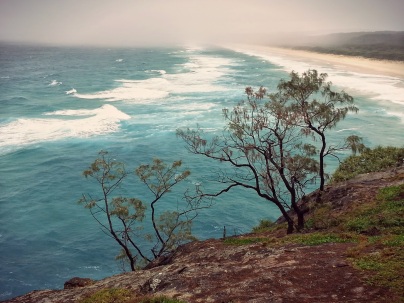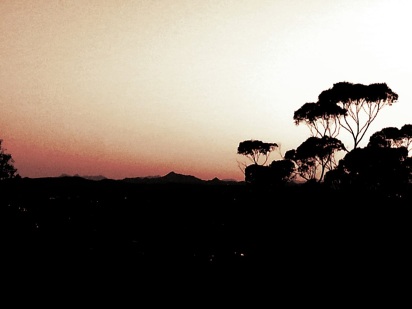Excerpt from Fall 2014 student Tim Almquist’s blog “A Season Down Under“. Reproduced with permission.
When I pulled up my blog to write a new post, I was ashamed, realizing it had been five whole weeks since my last post! I guess this says a little about the nature of my time hear in Australia. Now I will tell you more.
Hope you enjoy.

Uni Life
In Australia, people like to shorten the names of things and add a “y” sound at the end, giving, In my opinion, a trivial and laid-back feel. “Uni” is what Australians call University, college, or simply school. But calling higher education “school” is culturally degrading, so I have now adopted this and refer to George Fox University as “Uni.”
The last few weeks have definitely reminded me that though I get to pet kangaroos, take my day off and snorkel, my adventure is mainly an academic one. I am finding a difficult balance, in some ways, with being a full time student in the classroom and a student of another culture and place. But, I have adjusted to being a student now and I am grateful for the things I am learning.
On Monday I spend three hours in my Indigenous world views and Aboriginal Cultures class. I have found this subject to be a deepening one, as it forces me to think very critically with how I understand my own western worldview. Particularly in my experience, I am learning how my context involving family, cultural values and my church tradition, has shaped what I believe about the World, God and myself. It is uncomfortable to encounter my own worldview by learning another’s but I am convinced it is nothing but healthy. Particularly with spirituality, I am learning how dualistic my own journey and the systems I have been in for a lot of my life really are. A quote from one of our class readings will help to clarify what I’m getting at: “Aboriginal Society was so spiritually integrated that it is difficult and misleading to classify it in the usual way–work, education, social life, home life, leisure, art, religion. Seeing no churches for example, most Europeans thought that Aboriginal people had no religion. They were wrong. Aboriginal religion was not something separate on Sundays but the centre of existence, impossible to separate from any aspect of life” (from Nigel Parbury’s: Survival, A History of Aboriginal Life in New South Wales, p. 13). This understanding of spirituality amazes me and it is an understanding I feel that I have been longing for personally, for a long time. I have wondered why in my own faith tradition there seems like such a disconnect between those activities deemed “religious” and the mundane tasks such as driving to the grocery store or taking out the trash, that actually, in a lot of ways, contextualize the truth of my daily existence. Learning about the ways in which another culture understands differently the same world I live in gets me to analyze my own culture. It is a crucial experience.
On Wednesdays, I attend my Ministry Formation class. The ministry school at Christian Heritage College is in conjunction with Citpointe Ministry College, located in the building of Citipointe Church, down the hill from CHC. So, I spend just as much time on CHC’s campus as I do at Citipointe, primarily in their hip coffee shop. I don’t know if I’ve ever seen so many middle aged men wearing skinny jeans. Here in Australia, it appears that they were the ones who started this fashion statement. Citipointe, in my Quaker understanding is about as “mega church” as they get. Rock ‘n’ roll worship streams over the speakers and there is a hustle and bustle on the church grounds each day of the week. I walk downstairs to the college classrooms and join the ministry students, of which I’m finding very welcoming. This past week, I turned in my first of two papers: a 2500 word argument of how ministry and mission must be done with the goal of God’s redeeming kingdom being encountered here on earth as in heaven. I am proud of my work and will receive a grade soon.
My other ministry course, which I attend Thursdays is History of Christian Thought and its Practice, and is my favorite class. Our lecturer reminds me of my Philosophy professor back home. We study different ways of thinking and how they have developed throughout church history. The Wesleyan Quadrilateral, Hebrew holistic worldview vs greek dualistic, and modernism vs post-modernism. For our first paper, I argued that fundamentalism (primarily in an American atmosphere starting in the early twentieth century) has shaped evangelical systems of ecclesiology today. I also argued that fundamentalism has a very ironic relationship with modernity, in that it generally tries to deny progressive developments like science and certain levels of biblical criticism; yet at the same time classifies faith into a kind of reasoned, rational equation, focusing on facts or proof as modernists would. My paper received a good grade and my professor enjoyed my argument very well.
On Friday, I join the other American students with our program directors for an all day class on Australian history, politics, and culture. We engage in good discussions about current global issues and learn how the United States is perceived from an Australian perspective. The Australia Studies Centre puts a huge emphasis on our Telos (belief) and Praxis (practice) being integrated throughout our vocations. We read an article by Steve Garber, an author and teacher who I happened to hear speak at a small luncheon with George Fox University student chaplains last spring. We watched a fascinating lecture on the gospel and culture by James K.A. Smith. I loved it very much and felt that his words affirmed the same longings I have for holistic faith that I mentioned above. We have also been acquainted with various lecturers at the Uni and their understanding of both Australian and American cultures. We have learned what are some hot button political topics here in Australia. One being the asylum seeking refugees who risk their lives and travel by boat from places like Indonesia yet are not let in and sent to detention centers on different islands by boarder patrol and customs. Sounds similar to another situation current in our own American scene. One stereotype Australians have of Americans, is that we all have guns. Australia is proud of its country-wide ban on guns since the massacre in Port Arthur, eighteen years ago. I find this absolutely amazing that the common response to the killing of thirty-five people was to give up certain freedoms of gun ownership. Not everyone was happy, but the buy-back of 700,000 guns says something about the deep Australian value of communal safety and camaraderie. In an in-class panel with Australian lecturers, when asked what advice to give us young American adults, one said: “put away your guns and use your words.”
AFL & Rugby League
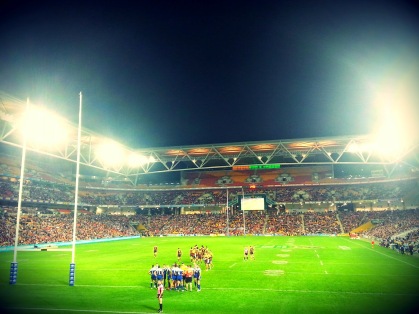
I had the privilege of going to one NRL Brisbane Broncos game, and three AFL Brisbane Lions games. These are all versions of “football” in Australia. The Broncos play what we may generically call rugby back in the states, but there is an important clarification to make. Two types of rugby exist: rugby league and Rigby union. The Broncos play league, and Union is a more elite version. There’s an australian saying that goes: “union is a gentlemen’s game played by thugs, and league is a thugs game played by gentlemen.” Whatever the case, there is tackling in both. Now, AFL or “Aussie Rules,” is a cross between soccer and rugby, in my opinion and originated from the Aboriginals. There is still tackling, though the goal is simply to kick or “punt” the ball between two tall goalposts similar to the NFL. So far, AFL seems to be the most popular and my host family are huge supporters of the Brisbane Lions. Yes, in Australia they call fans supporters, which is a sign of proper British culture.
Snorkeling “The Wrecks”
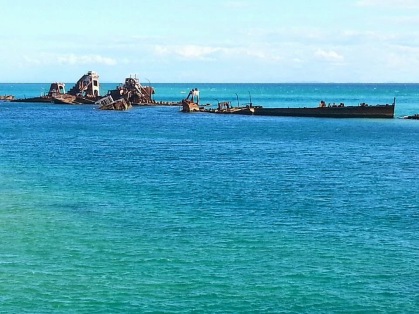
On Tuesdays, myself along with a few other American students do not have class. Do we take the day to study? Mostly not. Instead, we do things like pet kangaroos and go snorkeling. A couple weeks ago, four of us, including myself, woke up early and caught a ferry leaving the Port of Brisbane for Moreton Island. Moreton Island is home of the Tangalooma Wrecks, a man-made reef of sunken ships off the bayside shore. Our ferry ride was about an hour and a half, and we arrived at Moreton Island to a white sandy beach and green and blue ocean. We rented wetsuits and snorkeling gear and the rental guy showed us how to swim from the beach through the northern current, and get to the long line of sunken ships. He showed us what kind of fish we should see and assured us no sharks or jellyfish should be near us. The current was strong and I had a bit of trouble getting back to shore. We knew why the rental guy told us barely anyone goes out during winter when we had trouble seeing through the mirky swift waters. My legs cramped up badly on my way back in, and I was sore for a few days afterwards. Our boat ride home was accompanied by free coffee and two dolphins swimming past us as the sun set over the land of Oz.
North Stradbroke Island
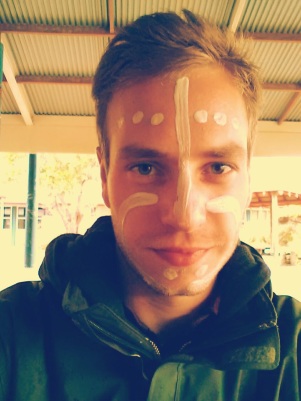
Last weekend, the group of American students, along with the program directors and lecturer of our indigenous world views and Aboriginal cultures class, took a ferry ride to North Stradbroke Island, originally called Minjerribah, which is directly south of Moreton Island. The weather was less appealing, though we saw blue jellyfish about the size of volleyballs swimming near our boat. We stayed on the Island for a night in a hostel-type accommodation in Dunwich, where we also ate meals, had class discussion and a few others and I led a time of Sunday morning worship. We learned from local Aboriginals Craig and Matt about some of the history of the Island and the culture of the Quandamooka People, the local Aboriginal people group. It was fascinating to engage with the Aboriginal traditions, getting our faces painted with the totem of a stingray, throwing boomerangs, and learning some traditional dances. I had chills when we all, with painted faces, danced with Matt and his daughter. Matt told us the story of the didgeridoo, introduced us to traditional hunting weapons and lit a fire using nothing but grass and bamboo. Later that afternoon, we drove up north to Point Lookout to take a walk around the coastline. As we walked, four wild kangaroos ate on the hillside next to us and further down, we spotted dolphins and wales. The weather was very harsh and I will remember the power of this vast scene. Our group had a long in-depth discussion back in Dunwich about racial reconciliation among first-nation peoples in Australia and America. It was very convicting as a white individual to acknowledge the systems of institutional and individual racism that still utterly permeate our western society. I found myself saddened and in deep pursuit for new justice.
Australian Government
This last week, we were introduced to the Australian Government. We learned the relationship in the Constitutional Monarchy, with the Queen, the Governor-General and Prime Minister. Voting here is compulsory and citizens receive a fine if they choose not to. The upside is that it gives more equilibrium among different class representation at voting polls. If everyone over eighteen is forced to vote, it allows more people to have influence in the government. On the other hand, this required system makes chances greater for careless voting. Voting is also preferential which suggests that Australians “can’t waste their vote.” It means voters rank their preferences and when one candidate is ruled out, the second preference gives sway to the candidate in the lead until one gets more than fifty percent to win the election. Our class took a tour of the Queensland Parliament House, getting to learn its history and getting to see the special red chair designated only for Queen Elizabeth on the slight chance she would come to Brisbane.
Until Next Time
Personally, I am enjoying this country and what it has to offer. I am particularly blessed by the sense of community and shared spirit of kindness Australians give. My host family is incredibly loving and it is amazing how much we have in common. I could talk for ages with my host dad about theologians and authors, the church and our similarly-felt desires for the Church. My host brothers welcome me into the jovial banter of the home and my host mom is quite a servant. In some ways I feel right at home, though it doesn’t take long before I start counting down the days I have left. Learning about where I have come from, because I have entered a realm outside of that, is growing me deeper and fuller into a spirit of thankfulness and posture of wonder. I have much more to look forward to, including a weekend in the Outback, a trip to Sydney, another snorkeling adventure at the Great Barrier Reef, and more papers to write. I am grateful.

